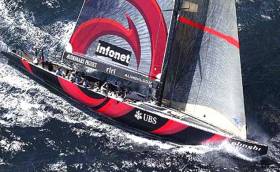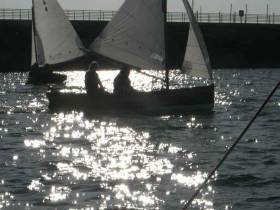Displaying items by tag: Water Wags
National YC Offers Water Wags Pre-Race Open Coaching Series
The National Yacht Club in Dun Laoghaire is offering a pre-race coaching series to help Water Wags sailors preparing for evening racing on Dublin Bay.
This series will be led by the club head coach and may receive the input of other coaches with the aim of improving starting techniques, tactical and strategical positioning in displacement boats and have the participants fully warmed up before the evening race.
The plan is to gather afloat from 6pm for practice (coach will be on hand from 5.30pm on the NYC platform and will communicate the daily plan via the class WhatsApp).
The series will be divided into two parts. The first, ‘Nailing the Starts’, will run on Wednesdays: 24 April, 15 May, 22 May and 29 May. The price is €50 per boat for all four sessions or €15 per boat for just one session.
Part two, ‘Clean Air Management and Practicing the Busy Corners’, will also run on Wednesdays: 5 June, 19 June, 26 June and 3 July. Like part one, the price is €50 per boat for all four sessions or €15 per boat for just one session.
For booking information, see the NYC website HERE.
Kilrush Skiff Sailors Discover Dublin Bay Water Wags Have Become Icons Of France's Morbihan Classics
The St Ayles skiff Ealu, new-built by Seol Sionna in Kilrush, has been entered for this year's edition of the vast and deservedly legendary Semaine du Golfe for traditional and classic boats at the Morbihan in Southern Brittany from May 15th to 21st 2023. And in so doing, the Sailors of the Shannon have revealed that when the Dublin Bay Water Wags attended in strength in France at the previous event in 2019, they didn't go unnoticed despite the huge size of the fleet. On the contrary, the unmistakable clinker-built hulls of five Water Wags in all their varnished glory feature prominently in the event banner at the head of the Morbihan event's promotional material
 Morbihan promotion via Dun Laoghaire. Beyond the blue hull, there are five immaculate Dublin Bay Water Wags as seen at La Semaine du Golfe in Southern Brittany in 2019
Morbihan promotion via Dun Laoghaire. Beyond the blue hull, there are five immaculate Dublin Bay Water Wags as seen at La Semaine du Golfe in Southern Brittany in 2019
STEVE MORRIS OF KILRUSH BOATYARD fills us in on the background and gives additional welcome news of the Shannon cutter Sally O'Keeffe:
"Éalú is entered into this year's Breton festival on the Morbihan, at present 10 Seol Sionna members will be travelling with her in mid-May, but that number may grow.
Yesterday, Saturday, February 25th February, we also started training for this year's Ocean to City race/rally at Cork in June with a lively row around Kilkee Bay, and weather permitting, we will be bringing Ealu to various spots on the Clare coast to continue our preparation for that event.
Our 25ft traditional cutter Sally O'Keeffe's mast is on the trestles for varnishing, and the other spars were beautifully varnished late last year by Max and Erwan from Skol ar Mor in Brittany while they were on three weeks of work experience with me in Kilrush - we hope to link up with them at the Golf de Morbihan event in May.
 Although "only" 25ft in overall hull length, the Myles Stapleton-designed Shannon cutter Sally O'Keeffe - community-built at Querrin near Kilrush - is versatile and roomy
Although "only" 25ft in overall hull length, the Myles Stapleton-designed Shannon cutter Sally O'Keeffe - community-built at Querrin near Kilrush - is versatile and roomy
Tentative plans were being discussed to attend this year's WIORA Championship in the Aran Islands from 5th to 8th July with Sally O Keeffe, as last year's event based out of Kilrush was thoroughly enjoyed by all the Sallys. Our usual crew training course based around Sally O Keeffe will of course, also go ahead this year.
Meanwhile, the skiff is wonderful at sea. Kilkee was lively on Saturday, but with six on board, we managed to easily row out to the mouth of the bay, yet there was barely a cupful of spray in the bilges when we got her back on the handy trailer after a two-hour session, a real endorsement of her Nordic design heritage and the concept refinements of Ian Oughtred and Alec Jordan".
Steve's mention of Skol ar Mor is a reminder that this Breton boat-building school, having created the new Howth 17 Footer Orla in 2018, has many other links with Ireland. And that in turn, reminds us that when the Howth 17s attended the Semaine du Golfe in 2015, they frequently found themselves in close proximity with the Eric Tabarly 43ft gaff cutter Pen Duick, a Fife design built at Carrigaloe on Cork Harbour in 1898.
 Pen Duick in the Morbihan with Howth 17s - the combined age of the boats in the photo must be nearly 500 years
Pen Duick in the Morbihan with Howth 17s - the combined age of the boats in the photo must be nearly 500 years
Wednesday night's regular Water Wag races also served as the fleet Frank Keane BMW George Regatta races at Dun Laoghaire Harbour.
A 26-boat fleet sailed one light airs in-harbour Jubilee Cup race won by Wag number 45 Mariposa sailed by Cathy Mac Aleavey and Con Murphy of the National Yacht Club.
In a tight finish (see vid below) Vincent Delany and Emma Webb of the Royal St. George Yacht Club in number 3 Pansy were second. The Royal Irish's Swift number 38 Guy and Jackie Kilroy finished third.
 Water Wag number 1 Ethna finished fifth Brendan Briscoe
Water Wag number 1 Ethna finished fifth Brendan Briscoe
The RSTGYC prize winners were Mariposa (Div 1A), Mary Kate (Div 1B) Mike and Ian Magowan, Chloe (Div 2) Kate and Guy O’Leary.
As Afloat reported previously, after the disappointment of the blowout of last weekend’s (June 25) RIYC Regatta, this weekend’s Royal St George big event on Saturday 2 July is much anticipated on Dublin Bay.
The George Regatta brings to a close the annual waterfront regattas for 2022 at Dun Laoghaire, which began on 12 June with the DMYC Regatta and was followed a week later by the Davy NYC Regatta.
Online entry is still available for the event, which comes with an equally packed onshore programme that promises a great day of fabulous food and family entertainment along with the excitement of racing on the water.
Water Wag 'Swift' Takes the Gun in Newsom Memorial Trophy Race
On 22 August, Division 1A Water Wags raced the second match for The Newsom Memorial Trophy, while division 1B raced for The Hilpotsteiner Tankard and Division 2 raced for The Phyllis Cup.
It was a warm evening in Dun Laoghaire, and at 17.30 hrs. there was not a breath of wind in the harbour. All the moored boats were lying to tide. A few dinghies struggled to make forward progress. Nevertheless, the ever-optimistic Wags rigged and launched. Their Race committee were adamant that they would lay a course and start a race. A small breeze arrived, firstly, from the west, and then from the south. By the time the windward mark was laid and a starting mark down, it was very evident that both were misplaced. Tweaks were undertaken. Then five minutes after the appointed time, the class flag went up. All of the Wags on the start line found it difficult to find any wind pressure, while those between the committee boat and the east pier lighthouse enjoyed a good 6–knot breeze.
A ‘U’ flag was hoisted, and later dropped and then the Wags started. Four miscreants were caught on the Course Side within the final minute before the start. At the start, there was a 4 knot breeze along the full length of the line. After the start, and it was difficult to tack out towards the harbour mouth, so, most headed into the ferryport where the pressure was lighter. At the windward mark, ‘Mademoiselle’, led from ‘Pansy’. On the offwind leg, ‘Mademoiselle’ remained on starboard tack while ‘Pansy’ gybed away on the port tack and selected the port hand leeward mark, followed by ‘Tortoise’. At the second windward mark the order remained the same, despite the two leaders sailed mirror reflections of each other’s courses. At the third windward mark David Somerville in ‘Ethna’ squeezed inside ‘Swift’ to take third place, but on the next run disaster struck. The entire fleet of spinnakers stole ‘Mademoiselle’s’ wind, allowing ‘Pansy’ to pull into first place, but not for long. Approaching the finish, ‘Pansy’ and ‘Swift’ crossed tacks. As they crossed the line ‘Swift’ put her lovely bow a half meter ahead, to take the gun.
For full results see below:
1st. Swift, Guy & Jackie Kilroy. Winner Div. 1A.
2nd Pansy, Vincent Delany & Emma Webb.
3rd. Mademoiselle, Doug Smith & Adam Winkleman. Winner Div. 1B.
4th. Patricia
5th. Tortoise
6th.Skee
7th.Mollie
8th.Swallow
9th. Vela
10th Peggy
11th Alfa
12th Freddie
13th Eva
14th Scallywag, Dan O’Connor & Hugh Delap Winner Div 2.
15th Barbara
16th Coquette
17th Little Tern
18th Badger
19th Chloe
20th Polly
21st Eros
22nd Dipper
23rd Sara
24th Nandor
25th Mary Kate
OCS Gavotte
OCS Phyllis
OCS good Hope
OCS Ethna.
America’s Cup Goes Back to Monohulls & Dublin Bay Water Wags Were First to Know
It has been confirmed that the next edition of the America’s Cup will see defenders New Zealand organise the racing in monohulls, after three stagings of the world’s oldest international sporting challenge in multihulls writes W M Nixon.
This will come as no surprise to those who were at the extraordinary Dun Laoghaire gathering twelve days ago when the 130-year Dublin Bay Water Wags celebrated their first race with more than thirty boats.
They partied in the Royal Irish Yacht Club with the crew and supporters of the Alex Thomson/Nin O’Leary IMOCA 60 Hugo Boss. It was a busy multi-agenda night, with the air well filled with stories old and new.
But as reported in Sailing on Saturday on September 2nd, one noted Dublin-based heavy hitter in the international sailing scene at the party was able to disclose that, with the support of top European America’s Cup interests, the America’s Cup next time round - in which Italian team Luna Rossa are the Challengers of Record – will be raced in monohulls.
The word was that they’d be skinny 73ft hulls with enormous keels, aboard which sailors will be seen to be people rather than robots. And it seems it’s all happening. But with the Mini Transat, the Volvo World Race, and the Rolex Middle Sea Race starting to come up the programme listings, there’s time enough before anyone starts losing any sleep over the next America’s Cup...
The intriguing story of how a ship’s gig of 1796 came to be quietly preserved in Bantry House is well known among classic and traditional boat enthusiasts writes W M Nixon. The elegant craft was left behind after the unsuccessful invasion attempt by France in southwest Ireland, and somehow was forgotten by the outside world until people like Hal Sisk arrived on the scene with useful ideas as to what might be done with this by-then unique vessel.
The Bantry Boat herself is now on conserved display in the museum in Collins Barracks, but her lines were taken off to enable replicas to be built with the inspired idea – from Hal again – that they could be used as the basis for training programmes and inter-regional competition on both sides of the Atlantic.
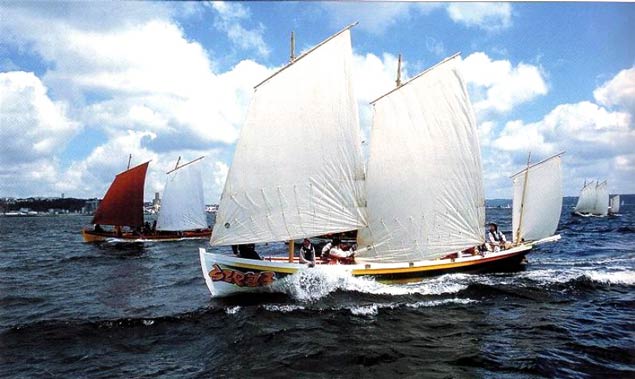 Revelling in it. The Bantry Boats get maximum enjoyment from the Morbihan festival.
Revelling in it. The Bantry Boats get maximum enjoyment from the Morbihan festival.
The current Festival of Sail on the Golfe de Morbihan in Southern Brittany (its proper name is Semaine de Golfe, but if we use that title, everyone expects Rory McIlroy to turn up) provides an ideal showcase for these lovely boats. Yet in a very mixed fleet which apparently is now approaching the 1500 mark, even the distinctive Bantry Boats can take a bit of finding.
It was the hawk-eyed Con Murphy (who’s taking part in the event with his wife Cathy MacAleavey in her new Jimmy Furey-built Water Wag Mariposa) who spotted the Bantry Boats as he ambled along the beach, and the image has winged its way to Afloat.ie.
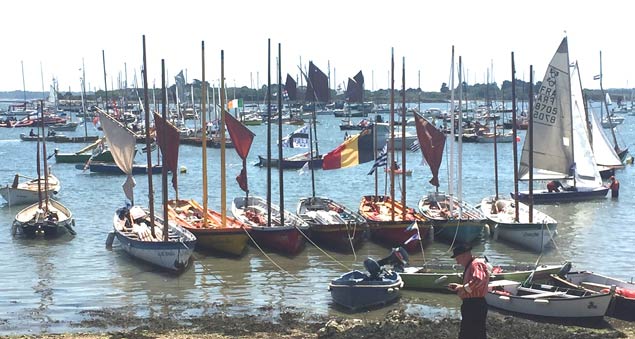 In a total fleet now approaching 1500 boats in the Morbihan, it took the hawk-eyed Con Murphy to spot the Bantry Boats bow-on and demurely at rest on the edge of the beach. Photo: Con Murphy
In a total fleet now approaching 1500 boats in the Morbihan, it took the hawk-eyed Con Murphy to spot the Bantry Boats bow-on and demurely at rest on the edge of the beach. Photo: Con Murphy
Meanwhile the Water Wags, far from letting themselves be dragged with indignity onto the beach, made for an impressive display in a neat row lying to a mooring, showing their gleaming brightwork to perfection. Those long off-season hours of preparation and sanding, and then varnishing when the temperature finally rose a little in the shelter of remote sheds in places like Kilpedder and Rogerstown, are this week paying big dividends on the international scene in South Brittany.
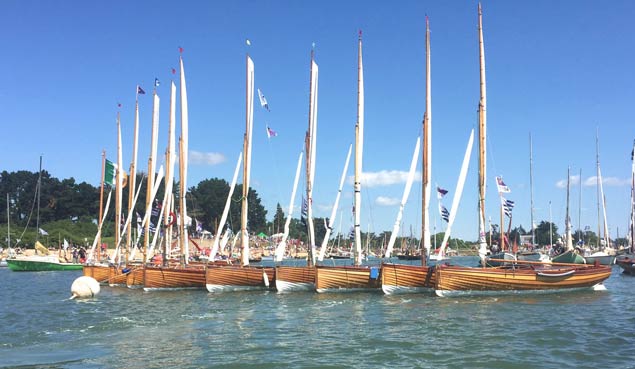 Shiny boats all in a row....The Water Wags looking their best in the Morbihan, an eloquent testimony to dedicated off-season hours of amateur preparation and varnishing. Photo: Con Murphy
Shiny boats all in a row....The Water Wags looking their best in the Morbihan, an eloquent testimony to dedicated off-season hours of amateur preparation and varnishing. Photo: Con Murphy
See more photos of the Morbihan Festival on Thierry Martinez's gallery here.
When you’ve 1400 sailing boats gently milling about, all in seemingly amiable confusion but with lots of warm sunshine, it’s an achievement to avoid a collision, and it’s a real breakthrough when you can recognise another participant writes W M Nixon.
For the 20 vintage Irish boats taking part in the Morbihan Festival of Sail in France – 14 Water Wags and six Howth Seventeens – yesterday’s opener with the inaugural Parade of Sail provided a flavour of what’s to come throughout the week. And last night, those whose boats didn’t provide some sort of overnight accommodation found themselves locating their homes for the week among hundreds of other shore-wandering sailors who’d spent the day being enchanted at the sight of so many boats of so many different shapes and sizes.
For that’s what the Morbihan Festival is ultimately all about. It’s an endless visual feast for all boat nuts of the true sailing kind. On the first day, you just keep gazing around you in wonderment. But after a while, you can even start on a bit of specific identification and analysis. That will begin today Tuesday – Day 2.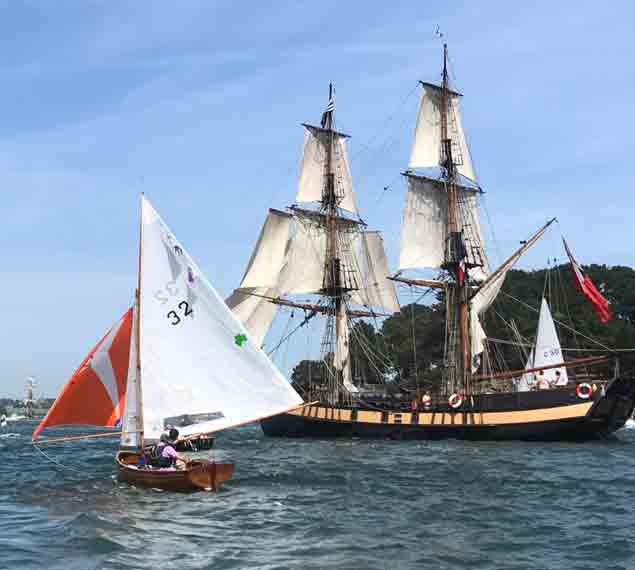 The 1985-built Water Wag Skee (named in honour of legendary boat-builder Skee Gray) shows a bit of racing experience with an effectively setting spinnaker and some interesting company
The 1985-built Water Wag Skee (named in honour of legendary boat-builder Skee Gray) shows a bit of racing experience with an effectively setting spinnaker and some interesting company
Within Dublin Bay there currently are twenty-one classes of racing yachts. It might come as a surprise to many, that currently the largest class is Dublin Bay is the Water Wag class with 33 boats entered for the 2017 season. With a big class, the first question that should be asked is: How many boats compete regularly in class racing? In the case of the Water Wags, 21 boats launched and reached the start line, which was set up for a wind coming at 135 degrees (south east) at about 7 knots.
The start line was set with a small bias towards the pin end, but despite an even spread of Water Wags over the full length of the line, the group closest to the flagship were OCS when there was 20 seconds to go to the start. A general recall was indicated.
On the second attempt to start the line bias was retained, and again some boats jumped the gun, so everybody was called back.
On the third attempt the fleet behaved properly, a ‘all clear’ was declared. It was a long beat with two choices, head towards the harbour mouth where one would have to nose the young flood time, or head towards the marina breakwater where the tide would be in your favour. Eva, Swift and Barbara headed to the harbour mouth, and found that they had more wind strength than those who headed inshore. At the windward mark the order was Eva, Swift, Barbara, Mademoiselle, Pansy. After one lap the order changed to Swift, Eva, Mollie. The race was two laps long and at the finish the order was:
1st – 38, Swift, Guy & Jackie Kilroy.
2nd - 41, Mollie, Claudine Murphy.
3rd.-33, Eva, Katie Tingle.
4th. Skee, Jonathan & Carol O’Rourke.
5th - 8, Barbara, Ian and Judith Malcolm
6th. – 15, Moosmie, David MacFarland.
7th- 3, Pansy, Vincent Delany & Emma Webb.
8th. – 42, Tortoise, William Prentice and Moselle Hogan.
9th. – 4, Vela, Philip Mayne & Brian Bond.
10th. - 46, Mademoiselle.
11th. - 44, Scallywag.
12th. -16, Penelope.
13th. - 45, Mariposa.
14th. - 31, Polly.
15th. –43, Freddie,
16th. - 6, Mary Kate.
17th. -18 Good Hope.
18th. - 20, Badger.
19th. -40, Swallow.
20th. - 34, Chloe.
21st. – 26, Nandor.
Overall series of three races is won by Swift.
24 Water Wags turned up on Wednesday 17th May for the first handicap race of the year. It is the first of three races for the Buckingham Cup for Division 1. Division 2 complete for the Wigham Trophy. When we say “handicap” it is not like Cruisers, where a timed handicap is applied after the race. The Water Wags do things differently. Each of the 40 Water Wags is allocated a starting handicap. If your handicap in 2 minutes - you start 2 minutes after the first starter
It was a breezy evening with 10-12 knots from the west north west.
First Wag to start was Adrian Masterson and Jeff Davys in Sprite, followed one minute later by Sara and Freddie. The next group of starters were Good Hope, Polly, Eva, Chloe and Scallywag. It was 6 minutes after the leaders when the Moosmie, Swift, Mollie and Tortoise started. The benefit of these races is that almost everybody can start and stay in clear air for the entire first beat.
This was the first race for No. 47, David Corcoran’s Welsh built Water Wag Peggy. Without a pecking order position, it was difficult to establish an appropriate handicap for her. She started 4 minutes after Sprite. It was also the first excursion for the experienced Mermaid sailor, Roger Bannon in Ethna.
With a force 3 breeze, the tide in the harbour was not significant. There were plenty of choices on places to go on the beats. It was a speed race. Over 4 laps of the harbour the wind progressively swung towards the south-west. Sprite (div.2) held the lead until the very end of the race, when Orla Fitzgerald and Dermot O’Flynn in Eva (div.1B) overtook her, and took the gun. Thereafter the order was Mademoiselle, Good Hope, Polly and Moosmie (div.1) first of the scratch boats, Mollie, Vela, Swift who lost much ground in a tangle, Tortoise, Freddie, Gavotte, Peggy, Little Tern, Nandor, Scallywag, Skee, Alfa, Pansy, Penelope, Ethna who suffered from a leak, Swallow, Chloe and finally Eros who was late for the start.
As long as the harbour is not obstructed by cruise liners, 24 Wags will continue to race in Dun Laoghaire harbour each wednesday until the middle of September
#dlregatta – With the Kinsale ICRA Nats/Sovereigns Trophy 2015 very successfully concluded last weekend, and a classic Dun Laoghaire to Dingle Race put stylishly in place before that, the feeling of another sailing summer busily in progress is all-pervasive. But while the image projected may well be one of stately progress by the cruiser-racer fleets along the Irish coast, taking in an offshore race here and a regatta there with much leisurely cruising in between, the reality is usually otherwise. For those boats doing significant segments of the programme, it's a case of fitting chosen events into the usual hectic early summer life of work and family commitments and exams and everything else, with the re-location of boats to the next venue being a hurried task undertaken by delivery crews.
Next week sees the mid-season peak of the sailing summer, with the four day Volvo Dun Laoghaire Regatta 2015 in Dublin Bay from Thursday July 9th to Sunday July 12th. In a way it is an amalgamation of all that has has already occurred in this year's season, together with new elements to make it a unique sailfest which celebrates the fact that the citizens of Ireland's capital city and their guests can be conveniently sailing and racing within a very short distance of the heart of town. W M Nixon sets the scene
In the dozen or so years since its inception, the biennial Volvo Dun Laoghaire Regatta has settled itself firmly into the sailing scene as an exceptionally varied event in terms of the boats and classes taking part. There are five regular cruiser-racer classes, plus an offshore division, fourteen one design keelboat classes, and nine dinghy classes. And although there are contenders from Ireland's north coast and from the Cork area and south coast too, together with one gallant entry from Galway, it is essentially an Irish Sea Sailfest, though with a remarkably strong Scottish presence.
However, it was on the coast of Wales at 8.0pm last night that this sailing celebration began, with an ISORA Race starting in Holyhead and heading for Dun Laoghaire to set this large and complex programme into action towards a culmination on Dublin Bay in eight days time with the conclusion of VDLR2015.
2015 marks the Bicentennial of the Royal Dee YC, which was founded in 1815 on the Cheshire shores of the River Dee estuary where northwest England marches with northeast Wales. Originally the Dee Yacht Club (and founded, it's said, a month or two before the Royal Yacht Squadron came into being in the south of England, making the RDYC the second-oldest Royal yacht club in England after the Royal Thames), the Cheshire club became the Royal Dee YC in 1847.
Although the great prosperity of Liverpool in the 19th century saw the club's fleet of substantial yachts gathered in the Dee and then increasingly in the Mersey, by the late 1900s it was looking to the Menai Straits area as the focus of its keelboat events. As well, the completion of Holyhead breakwater in 1873 added a new and important harbour to its list of possible big boat sailing locations, and there was an increase in the number of cross-channel "matches" which the Royal Dee and the Royal Mersey, in conjunction with the Dublin Bay clubs, had already been running for some years.

A Royal Alfred YC cross-channel match from Dublin Bay to Holyhead gets under way in 1888. Cross-channel links were strong in the latter half of the 19th Century, and with the new breakwater completed at Holyhead in 1873, a new venue was available both for the Irish clubs and those on the other side such as the Royal Dee and the Royal Mersey

The bicentenary logo of the Royal Dee YC. In 1815, this club on the Cheshire coast was founded shortly before the Royal Yacht Squadron in the souh of England, whose Bicentennial is being celebrated at the end of July.

Dun Laoghaire saw its first regatta staged in 1828, and participation by yachts from the northwest of England and North Wales was regularly recorded. This is the Royal St George YC regatta of 1871.
So when we say that the Royal Dee has always been a stalwart of offshore racing in the Irish Sea, we're not referring to a story spanning only the 20th and 21st Centuries. On the contrary, it goes well back into the 1800s. And now, with the revival of keelboat sailing in the Mersey with several of Liverpool's myriad docks being given over to recreational use, we have in a sense come full circle with enthusiastic Dublin Bay support of the Bicentennial celebrations reflecting sailing links which go back almost 200 years
The Lyver Trophy is the Royal Dee's premier offshore challenge, and this year it is special, as it's a fully-accredited RORC event counting for points in the annual championship, and a highlight of the ISORA Programme 2015. It's start scheduled for yesterday evening in Holyhead will see the fleet – mostly regular ISORA contenders – sail a course of at least a hundred miles before finishing in Dun Laoghaire. Then as VDLR 2015 gets under way, races in it, combined with the Lyver Trophy results, will count as part of a series towards finding an overall winner of the RDYC Bicentennial Trophy.
Only entrants in the Lyver Trophy race are eligible, and for that race itself – which can be followed on the Averycrest Yellowbrick Tracker - the favourite has to be the Shanahan family's J/109 Ruth, still buoyed up by her great victory in the Dun Laoghaire to Dingle Race three weeks ago.

Back in The Bay – the Shanahan family's J/109 Ruth will be back in her home waters of Dublin Bay after winning the Dun Laoghaire to Dingle Race and completing the Lyver Trophy Race from Holyhead which started last night. Photo: David O'Brien
At the other end of the size scale, the VDLR2015 Dublin Bay programme includes several dinghy classes, and the biggest fleet will be mustered by the International GP 14s, who have designated the racing in Dublin Bay as their Leinster Championship. In an interview with Sailing on Saturday in March, VDLR Chairman Tim Goodbody emphasised that, overall, the event should be seen as a regatta rather than a championship, and for most boats that's just what it will be. But the GP 14s with their great esprit de corps have always done things their own way, and with their compact boat size – albeit comprising a large fleet of dinghies – they reckon they can get in a proper championship while sharing in the fun of the event.
 The brothers John and Donal McGuinness of Moville Sailing Club in Donegal are expected to be among the pace-setters in the GP 14 class with their superb Alistair Duffin-built boat. Photo: W M Nixon
The brothers John and Donal McGuinness of Moville Sailing Club in Donegal are expected to be among the pace-setters in the GP 14 class with their superb Alistair Duffin-built boat. Photo: W M Nixon

The GP 14 Ulsters 2015 were recently won on Lough Erne by Shane MacCarthy & Damian Bracken of Greystones
As to who is favourite, the McGuinness brothers – Donal and John - from Moville in Donegal, with their top-of-the-line Duffin boat built in Northern Ireland, have to be in the reckoning after being top Irish at last year's Worlds on Strangford Lough, but there's fresh blood in the fleet with the newest class developing at Youghal, while this year's recent Ulster Championship on Lough Erne was won by the Greystones duo of Shane MacCarthy and Damian Bracken.
The dozen and more boats coming south from Scotland, most of them substantial cruiser-racers, are testimony to a growing trend in sailing on Europe's Atlantic seaboard. Given a choice of venues, your average yachtie on this long coastline will incline to head south if at all possible. Other things being equal, it's reckoned the further south you go the warmer it is likely to be. And from the upper reaches of the Firth of Clyde, there are times when Dublin Bay might seem like the distant and sunny Mediterranean.
Maybe so, but we'd caution that much depends on the moods and location of that all-powerful weather determinant, the northern Polar Jetstream. In July, so long as it's well clear of Ireland -whether to the north or the south - we will have glorious high summer, and that occurred for the previous VDLR back in 2013, where the photos speak for themselves.
So we hope for the best in looking forward to welcoming a fleet of around 415 boats to Dun Laoghaire between July 9th and 12th, with all four of our in-harbour yacht clubs extending the hand of hospitality in a regatta tradition that goes right back to 1828. But while heritage and ceremonial are all very well in their place, it's the prospect of good sport which energises the participants and their sailing, and with several major contests already logged in 2015, what can we expect on the leaderboards next week?
At the top of the tree, Class 0 has formidable competition, including former Scottish champion Jonathan Anderson racing his XP38i Roxstar against the Royal Cork's Conor Phelan with the Ker 37 Jump Juice, which was one of the best performers in last year's ICRA Nationals at the same venue, and this year again became a force to be reckoned with as the breeze sharpened in the four day Kinsale ICRA Nats 2015/Sovereigns Cup a week ago.
 Freshly squeezed – her storming finish to last weekend's final race of the ICRA Nats/Sovereigns Cup at Kinsale makes Conor Phelan's Ker 37 Jump Juice one of the top contenders in the VDLR2015. Photo: David O'Brien
Freshly squeezed – her storming finish to last weekend's final race of the ICRA Nats/Sovereigns Cup at Kinsale makes Conor Phelan's Ker 37 Jump Juice one of the top contenders in the VDLR2015. Photo: David O'Brien
With a win in the final race, Jump Juice came in second to seasoned campaigner George Sisk's class overall winning Farr 42 WOW (RIYC), the pair of them in turn displacing the early leader, lightweight flyer Mills 36 Crazy Horse (ICRA Commodore Nobby Reilly & Alan Chambers, HYC) down to third in the final day's racing, so Crazy Horse will be hoping for a return of lighter breezes when racing starts next Thursday on Dublin Bay.
In the previous Volvo Dun Laoghaire Regatta in 2013, the most successful boat in was Nigel Biggs' much-modified Humphreys Half Tonner Checkmate XV, but this year the Biggs team is racing as Checkmate Sailing with the newest boat in the fleet, the Mark Mills-designed American-built C & C 30 OD Checkmate XVI. She may be only 30ft LOA, but she's such a hot piece of work with so many go-fast bells and whistles that she has a rating of 1.140 to put her in Class 0.
The oldest boat in the cruiser-racer fleets will be found in Class 3, where the 44ft Huff of Arklow is making an historic return to Dublin Bay racing. Originally built in 1951 by Jack Tyrrell of Arklow to a design by dinghy genius Uffa Fox, Huff is so-called because her concept is reckoned three-quarters Uffa Fox and one quarter Douglas Heard. The latter was the founding President of the Irish Dinghy Racing Association in 1946, and he later went onto to become Commodore of the Royal St George YC and a noted cruising and offshore racing enthusiast with this unusual boat, which is like a very enlarged Fying Fifteen with a lid – in fact, with her 30ft-plus waterline, she was described as a Flying Thirty. In recent years she has undergone a total restoration with Cremyll Keelboats near Plymouth in Devon, and Dominic Bridgeman of the Cremyll group will be racing her with trainee crews in her old home waters of Dublin Bay.

The Flying Thirty Huff of Arklow racing off Dublin Bay while under Douglas Heard's ownership in the 1950s. Built by Tyrrell's of Arklow in 1951, the hugely innovative Huff has recently had a major restoration, and will be making her return to Dublin Bay to take part in VDLR2015.
Among the newer boats on the bay, the 2013 champion Checkmate XV is still very much in the picture, but now she's owned by Howth's Dave Cullen, and took second overall in class in the Kinsale series a week ago. In Dun Laoghaire next week, she's with other Half Tonners at the lower end of the Class 2 rating band on 0.944, almost 200 rating points below the new Biggs boat. Class 2 also includes the Division 3 winner at Kinsale, Richard Colwell & Ronan Cobbe's Corby 25 Fusion (HYC) which bested VDLR 205 Chairman's Sigma 33 White Mischief in a real duel after they went into the final day's racing equal on points, while another Kinsale success story in the Class 2 lineup is Paddy Kyne's X302 Maximus from Howth, overall winner of the Portcullis Trophy for top ECHO boat.

Dave Cullen's modified Half Tonner Checkmate XV will be looking to take the top slot on Dublin Bay after being runner-up in Kinsale. Photo: David O'Brien
In between the two Checkmates on ratings, we find most of the cruiser-racer fleet, with Class 1 shaping up some interesting competition between the likes of Paul O'Higgins Corby 33 Rockabill (RIYC), Kenneth Rumball skippering the Irish National Sailing School's Reflex 38 Lynx, and two very sharp First 35s, Prima Luce (Burke, Lemass & Flynn, NYC & RIYC) and another former Scottish Series champion, John Corson (Clyde Cr C) with Salamander XXI.
This year's Scottish Series Champion and the Afloat.ie "Sailor of the Month" for May, Rob McConnell of Dunmore East, will certainly be racing in the VDLR 2015, but whether or not it's with his all-conquering A35 Fool's Gold (second in class at Kinsale) or aboard another boat (a Flying Fifteen) remains to be seen. And the Top Sailor Count doesn't end there, as there'll be at least four Olympic sailors involved in four different classes, with Robin Hennessy racing in what has all the marks of a quality International Dragon fleet against the likes of former Edinburgh Cup winner Martin Byrne, Annalise Murphy racing in the Moths which will surely be a change from the Water Wag which she raced with her mother Cathy MacAleavy (also another ex-Olympian) last time round, and Mark Mansfield helming John Maybury's J/109 Joker 2. After Joker 2's class overall win in Kinsale, we can expect a battle royal in the J/109s with boats of the calibre of Ruth for the National title fight.

The Shipman 28s find that the sport and socializing which the VDLR guarantees will provide some of their best racing of the year. Photo: VDLR
The J/109s are the queens of an impressive array of One Design keelboats which includes Sigma 33s (where VDLR 2015 Chairman Tim Goodbody's White Mischief is racing under the command of Paul McCarthy), Beneteau First 31.7s, Shipman 28s having one of their best gatherings of the year, Ruffian 23s with a good turnout, the attractive First 21s which are steadily gaining traction as a Dublin Bay class, and best OD keelboat turnout of all is by the Flying Fifteens, nearly all of them under the NYC flag.

Olympians all – in VDLR2013, Olympic sailors Cathy MacAleavey (1988) and her daughter Annalise Murphy (2012) raced the family Water Wag Mollie. But while Cathy will be sailing Mollie again this year, Annalise will be on her own racing a foiling International Moth.

Newest of the oldest – Adam Winkelmann and Doug Smith's new French built Water Wag No.46, Madameoiselle, has been launched in time for the regatta. Photo: Owen McNally

The Howth 17s of 1898 vintage will be the oldest class racing. Photo: David Branigan
Veteran classes include the IDRA 14s from 1946, the Glens from 1945, the Howth 17s of 1898 which pre-date the 1902 Water Wags, and the 1932 Mermaids, the latter being in the interesting position of no longer having an official division in Dun Laoghaire, yet it's a Dun Laoghaire skipper, Jonathan O'Rourke of the National, who continues to dominate the class both at home and away.
With large fleet numbers afloat guaranteed, the shoreside programme is appropriately busy, with the official side of each day's racing concluded by the evening's daily prize-giving at one of the four waterfront clubs. But with so many sailors involved, there'll be action in all the clubs – and at other establishments in Dun Laoghaire - throughout the week. The scene is set, let the party begin at a venue which has been staging regattas since 1828.
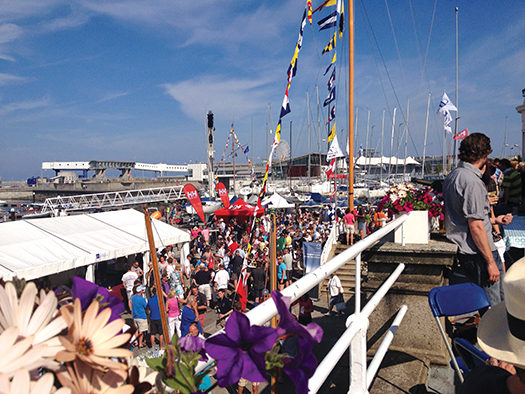
When the summer comes, the après sailing at the VDLR is world class. Photo: VDLR
Further reading:
Download the full entry list for Dun Laoghaire Regatta 2015 class by class below
Download the Sailing Instrcutions for Dun Laoghaire Regatta 2015 HERE
- Dun Laoghaire Regatta
- Volvo Dun Laoghaire Regatta
- Royal St George Yacht Club
- Royal Irish Yacht Club
- National Yacht Club
- ISORA
- Water Wags
- Royal Alfred Yacht Club
- yellowbrick
- GP 14
- Nigel Biggs
- George Sisk
- Annalise Murphy
- Half Tonners
- Tim Goodbody
- Mermaid
- Fool's Gold
- Dragon
- Irish National Sailing School
- Kenneth Rumball
- Dublin Bay






























